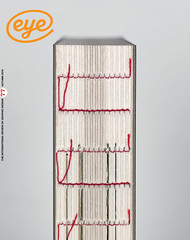Autumn 2010
British design myths dispelled
Modern British Posters: Art, Design & Communication
By Paul Rennie, Black Dog Publishing, £29.95While, on the surface, Modern British Posters seeks to chart the evolution of the British poster, this wonderfully detailed publication is really an admirable examination of the making of a profession. Although the years 1915 and 1970 serve as bookends to Rennie’s survey, at its heart is the mid-century shift ‘from art to communication via design’. Thus, the majority of the work featured in Modern British Posters was created between 1930 and 1950, the turbulent years that bridged the gap between the artist-craftsman of the 1920s and 30s and the new postwar graphic designer.
Many of the usual suspects are covered: E. McKnight Kauffer, Abram Games, Tom Eckersley and F. H. K. Henrion. But there are surprises, too. The work of Bruce Angrave and Leonard Cusden, for example, were revelations to this reader.
However, Modern British Posters is more than the sum of its parts. When reading it, I was compelled to think of Rainer Maria Rilke’s Dinggedicht or ‘object poem’ – his intense scrutiny of a thing or object that does not merely mirror the outside world, but reconstructs that object through an act of imagination and concentrated perception. In such moments something original is created, and an object emerges that offers a new vision of the world around us.
Although faced with the difficulty of having to weigh any decision against the objective evidence one is presented with, the writing of history echoes this subjective transmutation of raw material into a singular vision that holds true. This is especially so when contributing to the definition of a new field of study. Here the historian operates without the safety net of previous surveys and has to select works that can sustain and enrich our understanding of the material, events, and individuals examined. In such encounters, the way a historian goes about selecting their subject can be akin to the experience of falling in love. It is in this way that Modern British Posters reads like an extended love letter.
The posters featured in this anthology are all drawn from the collection of Paul and Karen Rennie, who met 25 years ago through a shared interest in the Festival of Britain of 1951. While trawling fairs and markets for examples of the festival’s graphic ephemera, the Rennies realised that the idea of British graphic design as resistant to Modernism was both ‘widespread and misguided’. Marking the mid-point in the absorption of Modernist ideas into British culture, the festival ‘promoted an integration of architecture, art and design as the template for the postwar reconstruction of Britain’. The posters that encircled this defining event revealed images of a country fuelled by a utopian vision, one that had taken the language of progressive Modernism and applied it across a range of themes and topics. It was from this period that the Rennies ‘began to explore the antecedents of the Festival, and discovered that it was ‘a manifestation of a long tradition in design reform that was attached to social progress in Britain.’
The overall tone of Rennie’s book is one of relaxed confidence in the rightness of the argument. If I have any criticisms, it is that many of the discussions feel clipped. Just as an interesting exploration of the work of a key designer or central element of the narrative starts to gather pace, we are abruptly swept along on to the next work – one always feels there is a fascinating back-story to each of the works shown. But then, this experience is common to many books on graphic design – writing a monograph on a designer can be like noticing many fascinating people and works through the window of a speeding train, never feeling able to stop and examine them more closely.
Also, although the book argues that British design shared the values of the localised Modernist experiments being played out in other parts of Europe at the time, it often gives a sense that Britain was acting in isolation. Greater detail of the interactions between the various strands of Modernist design across Continental Europe and Britain would have been interesting. Modern British Posters does an excellent job of refuting the argument that British design has historically been resistant to the progressive forms of design seen throughout Europe. It is destined to become a defining work in the history of the field.
First published in Eye no. 77 vol. 20 2010
Eye is the world’s most beautiful and collectable graphic design journal, published quarterly for professional designers, students and anyone interested in critical, informed writing about graphic design and visual culture. It is available from all good design bookshops and online at the Eye shop, where you can buy subscriptions and single issues.

